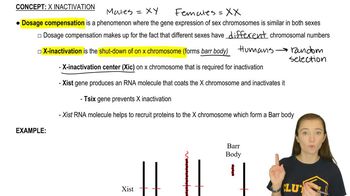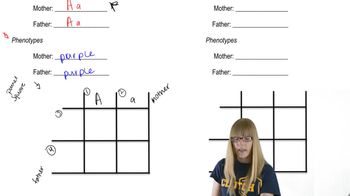Here are the essential concepts you must grasp in order to answer the question correctly.
X-linked Inheritance
X-linked inheritance refers to the pattern of genetic transmission of traits located on the X chromosome. In Drosophila, males have one X chromosome and one Y chromosome, while females have two X chromosomes. This means that X-linked recessive traits, like the vermilion mutation, are more likely to be expressed in males, as they only need one copy of the recessive allele to show the trait.
Recommended video:
Autosomal Recessive Inheritance
Autosomal recessive inheritance involves genes located on non-sex chromosomes (autosomes) where two copies of a recessive allele are required for the phenotype to be expressed. In this case, the suppressor of vermilion (su-v) is an autosomal recessive mutation that can mask the effects of the vermilion mutation when present in a homozygous or hemizygous state, demonstrating the interaction between different genetic loci.
Recommended video:
Phenotypic Ratios in Genetic Crosses
Phenotypic ratios describe the relative frequencies of different observable traits in the offspring resulting from a genetic cross. In this scenario, understanding how to set up a Punnett square for the cross between the wild-type female (homozygous for su-v) and the vermilion male will help determine the expected ratios of eye color phenotypes in the F₁ and F₂ generations, illustrating the principles of inheritance and gene interaction.
Recommended video:




